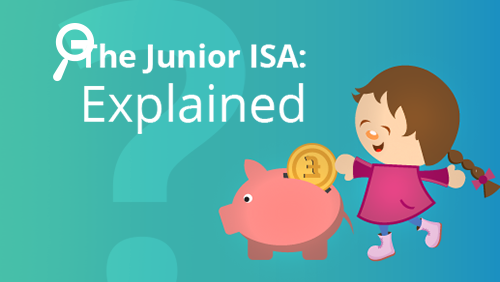Your read progress
Junior ISAs Explained
4 minute read
Updated 15th September 2025 | Published 4th November 2016

Learning to handle your finances properly is a skill many of us perhaps wish we’d picked up earlier in life. If you’re hoping to set your child on the path to a good financial future by setting up some kind of savings account for them, you may well be considering if a junior ISA fits the bill. Whether you’re planning to set up a nest egg for a babe in arms or you are looking to teach a child who is a little older about the benefits of saving for a rainy day, the Smart Money People introduction to Junior ISAs will help you get a handle on who is likely to benefit from putting their cash in a JISA.
What is the Junior ISA?
A Junior ISA is a tax-free savings account that is only available to those aged under 18. The current annual limit for a Junior ISA is £4080; this means that children can save this amount tax-free every year until they turn 18. Money held in tax-free ISAs cannot be accessed until a child turns 18 and at this time they will have complete control over those savings. You could suggest that your little one puts the funds towards university or buying a house, but ultimately, it will be their choice.
When were junior ISAs introduced?
You might remember the Child Trust Fund – these preceded the Junior ISA or JISA, which was introduced in November 2011. If you or your child has a Child Trust Fund you can continue to save with it using the same annual limit as the JISA. Or, you can transfer the funds to an ISA with a higher savings rate or move it into a child’s saving account.
Can I invest in stocks and shares?
In short, yes. Stocks and shares JISAs are available for children as they are for adults and just like ISAs, this type of account tends to offer a higher return in exchange for higher lending risk. However, only one cash or stocks and shares Junior ISA can be held at any one time. With this in mind, it pays to keep track of the rates being offered on junior ISAs of all kinds in order to transfer them when the opportunity to snag a better deal should one surface.
Who can pay into the junior ISA?
When it comes to paying into your child’s JISA it’s useful to know that all money paid into a JISA remains tax-free and continues to be even if a parent pays into it. This is in contrast to normal child savings accounts, which have specific rules that prevent parents from paying money into them and using them as an extension of their own Personal Savings Allowance. If a parent’s payments into a child savings account generate more than £100 in interest it will count towards the parent’s PSA, which could result in paying interest on the full amount if it causes them to exceed their allowance.
Is a Junior ISA a good investment?
With the current personal savings allowance set at £11,000 and some child savings accounts paying around 4 per cent (including the Halifax), a JISA is unlikely to be the highest earner for your young saver unless they’re grafting hard as an income tax payer who needs extra savings storage.
Those who don’t pay income tax can earn more than £17,000 in interest savings before paying tax and if they do, they will have an £11,000 personal allowance. Of course, if the amount of savings they have exceeds this then a JISA could be of help.
The fact that a JISA cannot be accessed until maturity at 18 can also be seen as a potential benefit if you want to lock down some cash for your child’s future. When they come of age the account will convert into an ISA and remain tax-free, however, you should remember they could also choose to take out and spend the money as they please.
What are the alternatives to a Junior ISA?
You will need to do your homework to find the best rates on child savings accounts but right now there are regular savings (online and in bank) paying around the 4 per cent mark. It’s worth noting that some of these accounts will limit how many withdrawals can be made from the account or ban withdrawals completely. They may also stipulate a minimum or maximum that can be paid in each month.
From a financial teaching point of view, having a more flexible account can help children to learn the impact on their savings of putting money in and taking it out. With this in mind, when money is not locked in they may have more potential to learn about money management though they will likely sacrifice higher rates of interest. When opening a child savings account you may find that an adult needs to be named to operate the account depending on the provider and your child’s age. However, having an adult named on the account can be of benefit in stopping your little one squandering their hard-saved pounds and pence.
Which junior ISA is best?
if you think a junior ISA could help to keep kick start your kid’s financial future check out our reviews to find the best Junior ISA offers and feedback from real customers like you. Got an opinion to share? Don’t forget to leave your own review.
Written by Smart Money People Team
As Featured By
Join our mission
We use the power of consumer reviews to help increase trust and transparency in financial services and to deliver industry leading insight and events.
Write a reviewExplore our other topics

News: Awards

News: Industry news

News: Smart Money People news

Guides: Smart money guides

Guides: Smart money tips

Guides: Business guides

Blogs: Money choices

